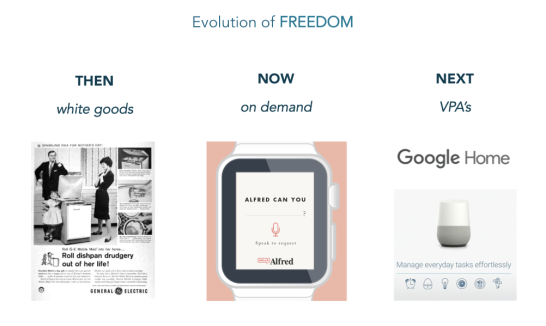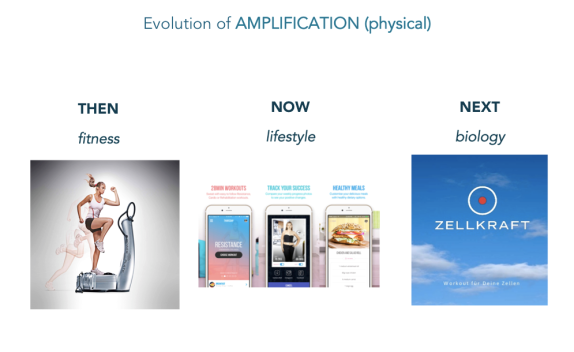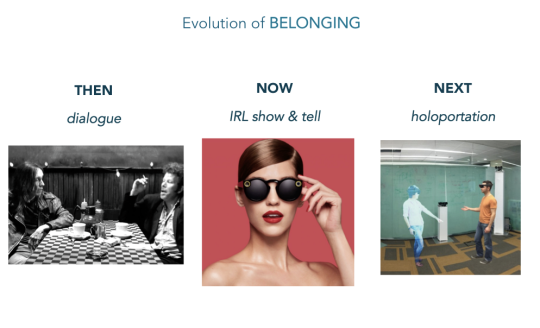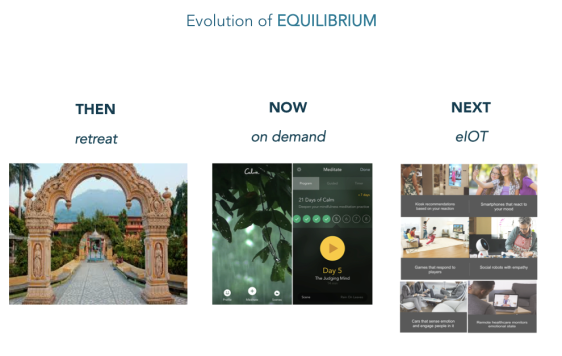Above image credit: teamLab
Designed by Product Innovation, and executed in partnership with C Space, Impressions of Connected Futures was a strategic research project that aimed to help us all imagine what people will need from connectivity and connected experiences in the near and distant future.
The study spanned five markets (DE, ES, UK, US, SKO). Within these, we had conversations and conducted experiments with 50 hyperconnected people between the ages of 16-24 (abiding to the rule of thumb that “if you want to know where things are going, look at what young people are doing now” – Dr Grant Blank, Oxford Internet Institute). Across three of them (DE, ES, US), we surveyed another 1800 people, specifically on the discoveries around attitudes and behaviours we made in the field. In addition to picking 20 expert brains across countries and continents, we also had the privilege of working with the Institute for the Future, who were commissioned to share their thoughts on what we might expect from connectivity infrastructures and the experiences these need to power by 2026.
At its heart, our exploration revealed a profound tension between the benefits and detractors of connectivity and connected experiences, which will also be the focus of these two blog posts. One the one hand, life was imagined to be freer and easier once connected experiences take on an even greater share of doing things on our behalf; on the other, life was perceived to be at risk of becoming a docile existence, filled with superficial relationships, glut, and uninterrupted escape into virtual worlds.
As innovators in an age of extremes, I would argue that becoming familiar with both ends of the spectrum is essential in the quest for opportunity. One end will present a need or aspiration to fulfil, whilst on the other end, a risk to mitigate or a problem to solve will crystallize. In turn, this two-part post will share insights and their implications across both ends of the spectrum, in hope to break the habit of only ever looking at well-trodden pains to solve on the subject of future connectivity. We will start with 5 needs.
Freedom <—> Exposure
Amplification <—> Dependency
Belonging <—> Narcissism
Growth <—> Absorption
Equilibrium <—> Overload
FREEDOM
Freedom, as a theme, is undoubtedly well trodden in our field – it was promised by the very nature of being mobile, no longer shackled to cables and sockets, and a popular high-order benefit telco advertising still draws on today. However, what people want to be free of has evolved. Today, freedom concerns itself with a collection of small stuff – daily tasks, decisions, activities that are menial, repetitive, difficult, annoying, and not least when the time they consume can be spent on more meaningful activities.
It’s no surprise Virtual Assistants, with their promise to take more and tasks out of people’s hands and off people’s minds, is in accelerated growth – whilst their predecessors (Facebook M, Google Assistant, Siri, Alexa) are enjoying mainstream adoption, the next generation of VPA start ups have raised $120m since 2015, and exploring the notion of being specialists as opposed to generalists.
From an interaction design point of view, voice (most recently at the heart of Apple’s new Air Pod proposition), will continue to be the interface of choice – at least until the software becomes so familiar with patterns, emotions, habits and tastes that it no longer needs commanding.

AMPLIFICATION
Whilst self improvement is as old a truth as mankind itself, there is, like with ‘freedom’, a new take on it worth considering. Existing physical and mental abilities like speed or memory will exceed constraints of bodies and brains through surrogate services; doing more (well) in less time will increasingly become a measure of and means for success.
People will therefore increasingly hand themselves over to services that will instruct them on what to do and when in order to achieve a desired physical enhancement or mental extension, irrespective of the erosion of their skills in these areas.
For her future, Olivia, one of our American participants, imagines one way in which this will manifest in her life:
“In 2026, my wearable maps out where I need to go. I don’t even have to go through the mental process when I travel anymore. It tells me when to get off the train; when to move left, move right.”
Data will inevitably play a vast role in ensuring extensions of minds and bodies function with some semblance to us and our highly personal needs. Under Armour’s Healthbox claims it will eventually link data from apparel, devices and wearables to fuel a coaching service, thereby amplifying the process of physical performance no ‘regular’ fitness coach could come close too (unless, perhaps, they were Excel and engineering aficionados).

Take a look at this Under Armour Future Girl video.
Looking ahead, biology is likely to be the next frontier for those who desire amplification. Whether it’s genes (CRISPR), intelligence (Nootropics), cells (Zellkraft), or even our limbs to better suit what they are needed for (Epibone), recalibrating our biology is the next frontier in our quest to amplify ourselves and our performance.
BELONGING
There are many, many ways to connect, communicate and share what we’re feeling, seeing or doing. All of which will continue to evolve and diverge how and what we share – from the raw to the staged, retrospective to real time, static to interactive.
Over half of our hyperconnected’s surveyed agreed their communications have become more expressive and emotive (compared to 1/3 of the general connected population). They reach for chat apps like Messenger, WhatsApp or Snapchat as soon as they wake, as only a confirmation that they belong helps them get their bearings and to start their day.
A strong desire to eradicate a felt distance between oneself and others whilst in conversation or show-and-tell mode was revealed by our participants near-obsession with holograms. As one of your citizen sci fi writers, Annie, explains: “[During downtime] I could call my friends and they could visit me as hologram. I could sit across from them on the couch. Would solve not feeling lonely when you’re bored.”
Implied in this, if you will, is a clear desire to feel someone’s presence viscerally, irrespective of distance – and perhaps a return to conversation in an age of virtual show-and-tell.
The next wave of communications apps that facilitate live streaming neatly meet this need; yet MIT’s Holosuite is a flavour of holoportation and therefore how you might eradicate the feeling of distance created by screens in the future.
Watch this Holosuite video: https://vimeo.com/136748726

GROWTH
Abundant high quality information that is increasingly easier to access and digest (on demand, audio-visual, gamified) will continue to spur a need for personal growth. People will continue to dedicate more time to draw on it in order to grow their professional skill repertoire, spiritually, interest-based expertise or simply to indulge sporadic bursts of curiosity (the kind that currently often leads to falling down ‘wiki-holes’ as one of our American participants called it).
As cited earlier, the need for Freedom is underlined by how being free from the mundane, everyday to do list and activities brings about free time for more meaningful ones. According to our discoveries, personal growth falls into the latter (although, lets not forget, ‘meaningfulness’ is subjective and in most cases also spans playing Pokemon Go or binge watching Netflix qualifies too).
Whilst a plethora of MOOCs enable structured learning, and services like classroom.io enable anyone to drop into a Stanford lecture, the next frontier will also concern itself with our biology. Trials, as expected, to ‘hack’ the brain (via a process called transcranial direct current stimulation) are currently underway in university and military labs across the world.
EQUILIBRIUM
People will aspire to and adopt technologies that will help them feel balanced and at ease. This entails attuning their external environments to the ever-changing nature of the internal or the physical, to ensure tastes are met, emotions responded to or even mitigated, and needs are catered to just as or even before they arise.
40% of our ‘hyperconnecteds’ surveyed claim to use products and services that restore their inner balance, whilst move than half feel confident that technology will help them achieve a better balance in their connected lives in the future. When we asked Patrick to imagine his life in 2026, he told us:
“Siri 2.0 cares about me. It asks me how I’m doing, and will suggest ideas for making my day better. It wants to help me get into and stay in a positive mood. I can also tell it to leave me alone for a while. I could be less connected as Siri 2.0 would be the one that dealt with everything for me.”
We’re seeing the emergence of objects that are able to listen, rather than simply track, to the constant flux of the physical and mental states, in order to meet the need for equilibrium. Products like Thync are designed to regulate the natural states by allegedly directly influencing the brain’s adrenaline system, calming the user when energy is in excess, or vice versa.
Looking ahead, we are likely to see affective computing enter the mainstream, by way of a more frictionless e(motional)IOT. All objects, wearables and devices will work in tandem, rather than in isolation, manipulating our environments and experiences to facilitate desired equilibrium. From a UX / UI perspective, our participants suggested maternal qualities are preferred when it comes to eIoT style services – those that listen, recognise and respond when it matters will trump those that simply, and functionally, execute.
——
Read part two of this article here.
The full report ‘Impressions of Connected Futures’ includes a thorough documentation of the fieldwork and its analysis, implications for innovation based on the aforementioned themes, as well as an overview of future technologies that we must ready our networks for. It is available on request from lucia.komljen@telefonica.com











